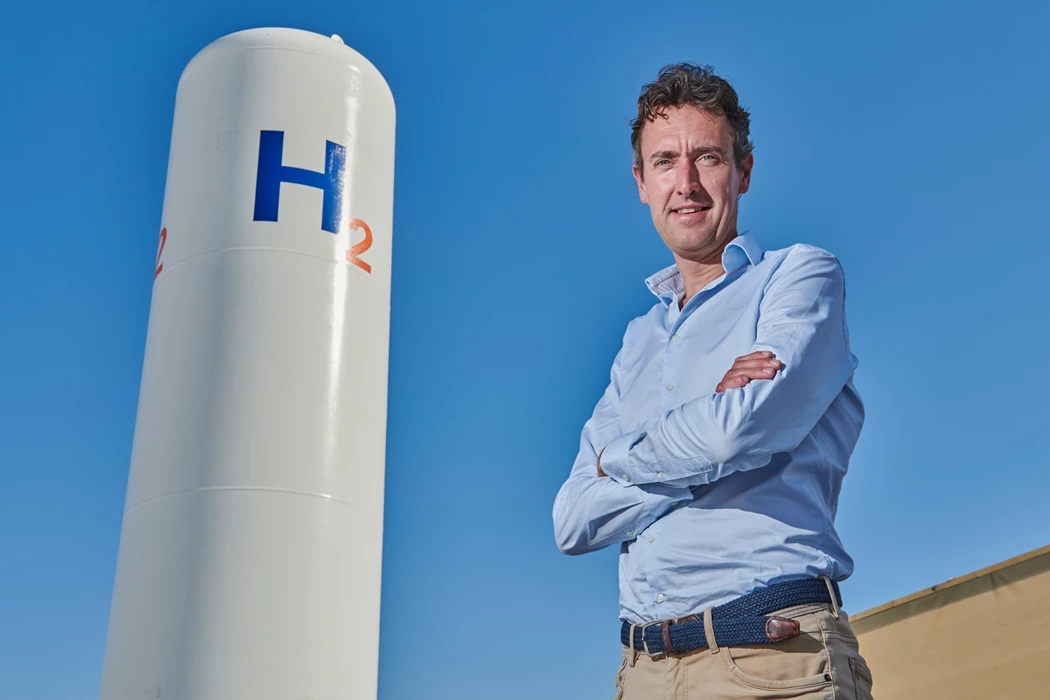Tycoon Sees $3.5 Billion Investments in Namibia Green Hydrogen
(Bloomberg) -- Cie Maritime Belge SA, a Belgian shipping company, expects green hydrogen production in Namibia to start in the fourth quarter, a project that could see $3.5 billion in investment over the next five years.
Belgium’s King Philippe on Thursday toured what’s expected to be Namibia’s first operating green hydrogen plant. The Antwerp-based shipping company seeking to power its fleet plans to open the first stage of the hydrogen fuel and ammonia project through a joint venture with Namibia’s Ohlthaver & List Group.
The facility will initially produce 400 kilograms (882 pounds) of hydrogen daily powered by a 5 megawatt solar plant near the port town of Walvis Bay. It’s expected to cost $30 million to build.
The project, known as Cleanergy, is part of a plan by the arid southern African nation to exploit some of the world’s best solar radiation and tap into Europe’s demand for green fuels. If successful, along with recent oil finds, it could transform the economy of the nation of 2.8 million people that currently relies on tourism, fishing and diamond mining.
“Our customers are asking us to clean up our act to make sure that we don’t emit carbon dioxide anymore. So we need to find an alternative for diesel,” Alexander Saverys, CMB’s chief executive officer, said in an interview at the site. “We wanted to be in a country where there’s an abundance of cheap renewable energy and Namibia is that country.”
The CMB plant, which will be expanded, will be followed by an ammonia terminal at Walvis Bay port. CMB is also planning to construct a 250,000 ton-per-year ammonia plant powered by solar at Arandis in the heart of the Namib desert. That will bring total projects costs to about $3.5 billion.
Vast Resources
When complete the project will allow CMB to venture into refueling large ships that dock in Walvis Bay - which lies on the route around the tip of Africa.
At the site near Walvis Bay solar energy is used to split water to generate hydrogen, which burns without emitting greenhouse gases and can be used to fuel trucks and small ships. At Arandis the hydrogen will be converted into ammonia, which is easier to transport and can be used to power large ships and heavy industry.
“All actors here share a vision of a green energy future,” King Philippe said in a speech at the event. “There is a bright future when I can see what we can accomplish together.”

CMB, founded in 1895, is controlled by the Saverys family. The Namibia plant will be its first outside Belgium, where it operates a small facility.
Namibia has vast resources including sun and wind that can be used to make hydrogen, Tinne Van der Straeten, Belgium’s energy minister, said in an interview. “But most important, we have a very like-minded vision and a very like-minded hydrogen strategy.”
The two countries signed an agreement at the COP26 United Nations summit in Glasgow in 2021 to develop the green hydrogen industry.
“It’s good that small countries can come together and do bigger things for other countries to follow,” Nangolo Mbumba, Namibia’s president, said in a speech at the event.
(Adds comments from king and president in ninth and last paragraphs)
©2024 Bloomberg L.P.
KEEPING THE ENERGY INDUSTRY CONNECTED
Subscribe to our newsletter and get the best of Energy Connects directly to your inbox each week.
By subscribing, you agree to the processing of your personal data by dmg events as described in the Privacy Policy.
More renewables news

Malibu Firefighters Make Gains on Blaze as Wind Warnings Persist

Longi Delays Solar Module Plant in China as Sector Struggles

SSE Plans £22 Billion Investment to Bolster Scotland’s Grid

A Booming and Coal-Heavy Steel Sector Risks India’s Green Goals

bp and JERA join forces to create global offshore wind joint venture

Blackstone’s Data-Center Ambitions School a City on AI Power Strains

Chevron Is Cutting Low-Carbon Spending by 25% Amid Belt Tightening

Free Green Power in Sweden Is Crippling Its Wind Industry

California Popularized Solar, But It's Behind Other States on Panels for Renters
















